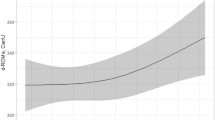Abstract
Objective: to assess the status of lipidsoluble antioxidants (carotenoids, tocopherols, ubiquinone), retinol and their correlation with TRAP (total radical-trapping antioxidant potential) in patients with Crohn’s disease.
Design: Prospective case-control study.
Setting: Clinic of Internal Medicine IV/Department of Gastroenterology and Hepatology, University of Vienna Medical School.
Subjects/Methods: Plasma antioxidant concentrations were determined in patients with Crohn’s disease (n=24) to evaluate the antioxidant capacity compared to healthy controls (n=33). Additionally, plasma TRAP (total radical-trapping anitoxidant potential) was measured in 13 patients and 22 controls.
Results: All investigated carotenoids (α-carotene, β-carotene and cryptoxanthin) were significantly decreased in patients with Crohn’s disease (10.2±9.3, 16.2±12.4 and 7.8±5.5 μg/dl) compared to controls (13.3±5,1, 34.7±18.8 and 48.5±38.4 μg/dl, respectively), whereas γ-tocopherol and ubiquinone were significantly elevated in patients (0.14±0.07 mg/dl and 2.3±41.5 μg/dl, controls: 0.09±0.04 mg/dl and 60.8±30.0 μg/dl, respectively). Retinol and α-tocopherol did not significantly differ from controls. The total radical-trapping antioxidant potential (TRAP) was significantly lower in patients (1.11±0.28 μmol/l) compared to controls (1.34±0.26 μmol/l). Antioxidants were neither related to duration or severity of disease nor to disease activity.
Conclusions: In patients with Crohn’s disease several plasma antioxidant parameters are altered and the total radical-trapping antioxidant potential is decreased.
This is a preview of subscription content, access via your institution
Access options
Subscribe to this journal
Receive 12 print issues and online access
$259.00 per year
only $21.58 per issue
Buy this article
- Purchase on Springer Link
- Instant access to full article PDF
Prices may be subject to local taxes which are calculated during checkout
Similar content being viewed by others
Author information
Authors and Affiliations
Contributions
Contributorship: D Genser collected the clinical data and drafted the manuscript. M-H Kang did the statistical analysis and helped with the preparation of the manuscript. H Vogelsang supervised the clincal part of the study. I Elmadfa was involved in the study design and supervised the laboratory work. All authors were involved in the revision of the manuscript.
Rights and permissions
About this article
Cite this article
Genser, D., Kang, MH., Vogelsang, H. et al. Status of lipidsoluble antioxidants and TRAP in patients with Crohn’s disease and healthy controls. Eur J Clin Nutr 53, 675–679 (1999). https://doi.org/10.1038/sj.ejcn.1600764
Received:
Revised:
Accepted:
Published:
Issue Date:
DOI: https://doi.org/10.1038/sj.ejcn.1600764
Keywords
This article is cited by
-
Association between genetic variants in the HNF4A gene and childhood-onset Crohn’s disease
Genes & Immunity (2012)
-
Oxidative Stress and Pathogenesis of Inflammatory Bowel Disease: An Epiphenomenon or the Cause?
Digestive Diseases and Sciences (2007)
-
Facteurs environnementaux dans la maladie de Crohn
Acta Endoscopica (2006)



